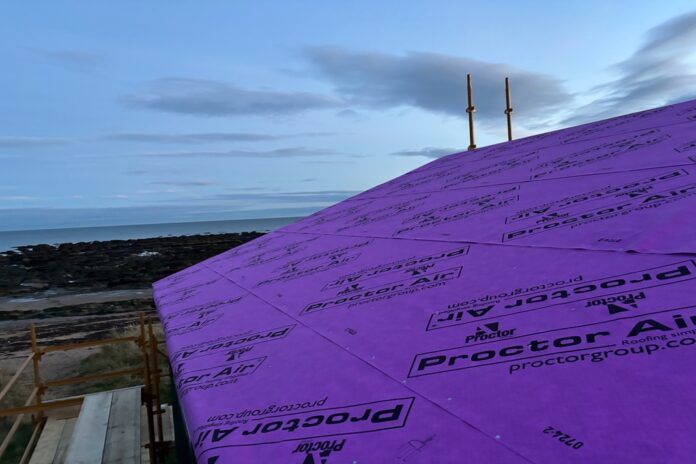A chemical engineer’s retirement project to convert a former fishing bothy is taking advantage of the benefits of two different membrane products from the A. Proctor Group: Facadeshield UV and Proctor Air.
The former boat house, complete with double doors leading directly onto a slipway
to the beach, has been bricked up for a decade. Now, it is being renovated by David
Gibson into a two-storey beach house, fulfilling a long-held ambition.
Facadeshield UV provides short-term protection to exposed walls
The existing boat house structure provided a tight footprint, being only 3.5m wide
by 8m long. David took the existing walls down to around one metre in height, and
then began the process of erecting the timber frame that would sit behind. All of this
allowed him to use the existing sleeper foundations.
Originally, he planned to use an open-jointed timber cladding as the finish above
the retained brickwork. He therefore chose the A. Proctor Group’s Facadeshield
UV membrane, which combines UV resistance, water resistance, and high vapour
permeability. Designed specifically for open jointed cladding, Facadeshield UV is also
dark in colour to provide a shadow effect in the open joints.
Ultimately, David had to amend his timber cladding specification to a closed system.
The boat house sits right on the boundary of his property, and fire safety regulations
necessitated a change in approach.
Nevertheless, the qualities of Facadeshield UV still proved useful. As David is
carrying out the work himself, progress can inevitably be slow – especially if weather
conditions are not favourable. The wall membrane was left exposed for three months
before the timber cladding was completed in January 2025, but it has protected the
OSB sheathing and timber frame well in that time.
Maintaining a traditional appearance
On the roof, David chose Proctor Air as an air permeable, low resistance (APLR) membrane, for use below a traditional slate finish. Maintaining a traditional appearance as part of the conversion work is important to David, given the building’s history of use.
The monopitch roof design made ventilation provision tricky, as David was specific in how he wanted to detail the ridge and keep it secure in the coastal location in Carnoustie. Selecting Proctor Air removed any such concerns, as it provides a uniform flow of air that effectively ventilates the roof space and removes any risk of condensation.
A tile or slate roof finish is the first line of defence against the weather. As water can get into the space below the tile or slate, the chosen underlay must also be capable of resisting water ingress. While not waterproof, Proctor Air has a W1 water resistance, and can be left exposed to UV for up to three months.
“Installing both membranes has all been quite easy and intuitive,” said David, before adding, “as long as it isn’t windy!” Although carrying out as much of the work by himself as possible, he did seek some help in getting the roof membrane installed, acknowledging “that it would be tricky for one person.”
Having an understanding of heat loss and dew points, David was happy to carry out U-value and condensation risk calculations himself. He has been grateful for the support available during the project so far: “I swapped a few emails with the A. Proctor Group technical team to check things were okay, and Building Control have been really helpful on site as well.”
At the time of writing, most of the external works to the boat house are complete. David will move on to the internal works, where he plans to use the company’s Reflectatherm Plus to the internal side of the timber frame.




